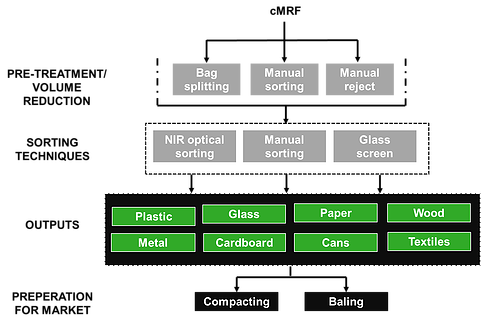A clean material recovery facility (cMRF) is suitable for the processing of dry, mixed recyclables that have been segregated.
The recyclables can be sourced from a number of suitable collections, namely a domestic household recycling collection, a commercial dry recycling collection or recycling collected by authorities at transfer sites / civic amenity sites / drop off points. A cMRF will typically handle metals, plastic, glass, paper and card, cardboard, textiles and waxed cartons.

Configuration
Technology restrictions
- Mixing of glass and paper will reduce the output quality of both materials
- Mechanical technologies required for separation of materials by grade are capital intensive
- Hand sorting can be used to varying degrees within the process
- Requires diligent separation of materials at source and low contamination
Main license requirements for cMRF
Advantages:
- Clean MRFs can be low technology
- The utilisation of manual pickers increases low skilled job creation
- Community involvement is key for collection and separation at source
- By-products have strong buy-back markets that will contribute to economic sector
Disadvantages:
- Limited to operate on dry recyclable material that has already been segregated
- Quantity and characteristics of waste, and quality assurance cannot be guaranteed
- Require co-operation and support from households to separate at source
- High use of water
Robinson Deep MRF, Turffontein, Johannesburg, Gauteng
The Kraaifontein Waste Management facility currently integrates refuse transfer of 1,000 tonnes per day with a semi-mechanised material recovery facility (MRF). It uses a combination of mechanical and manual technologies to sort approximately 100 tonnes per day of dry recyclables, which are separated at source and collected by the facility’s operator. The aim is to divert as much waste as possible from landfill sites and to facilitate economically viable recycling.
